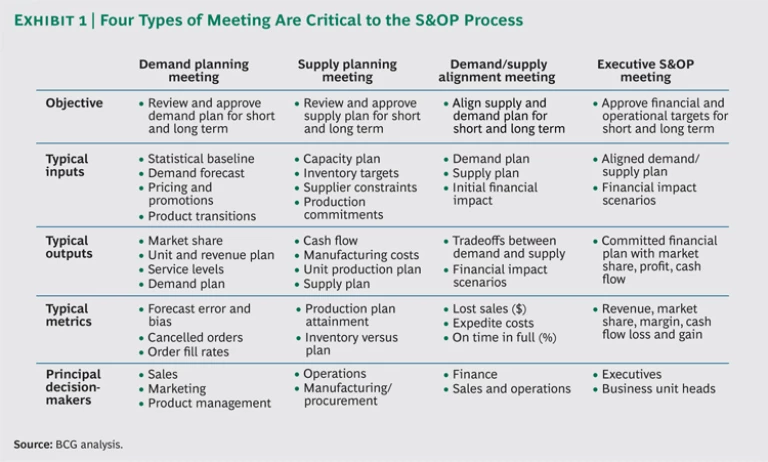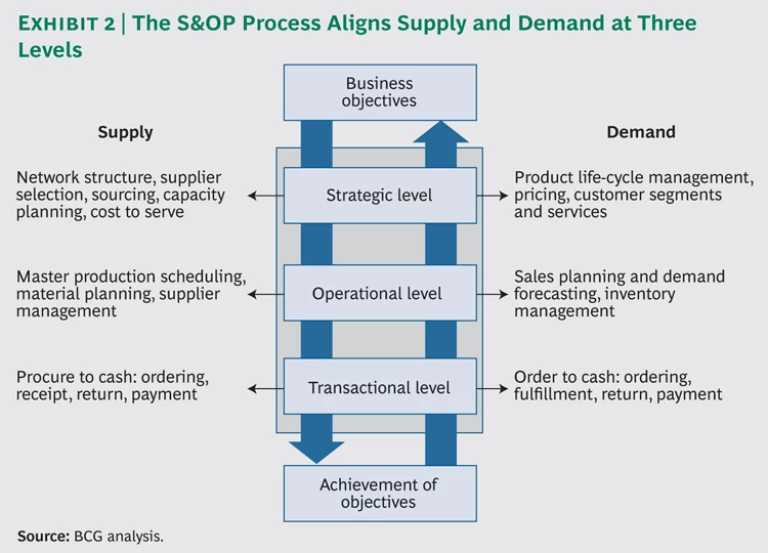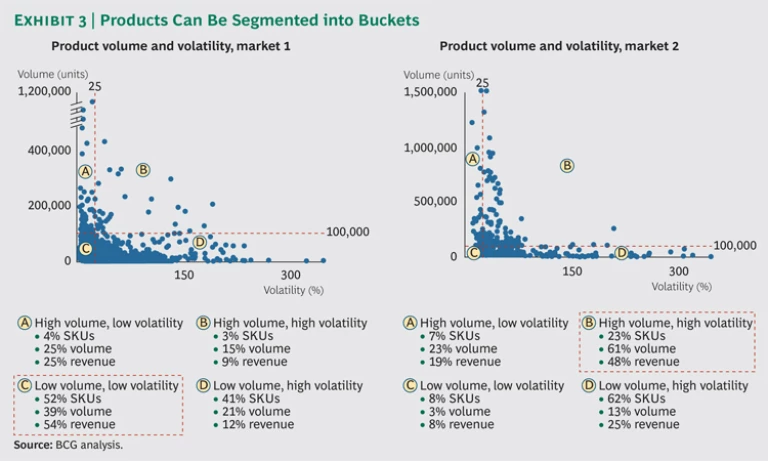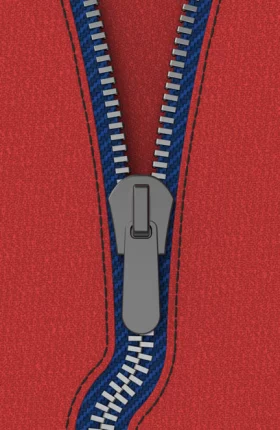When the right products aren’t in the right place at the right time, things can get ugly: stockouts and lost sales; inventory pileups, markdowns, and write-offs; poor capacity utilization and declining service levels. These costly problems are often symptoms of a broken sales and operations planning (S&OP) process. This key management process determines how much of which products to make, where to make them, and which markets to send them to on the basis of demand forecasts, cost factors, risk profile, and strategic objectives.
Decisions on how to allocate supply chain capacity tend to be hotly debated among the management team, especially when resources are tightly constrained. Often, a fundamental distrust between sales and production leads to padded forecasts, sandbagging, and other counterproductive behaviors—and heightened tension. These obstacles hinder the ultimate goals of the S&OP process: optimal use of the company’s resources and better customer service. If your company has ever experienced the frustration of product stockouts in key markets while inventory builds up in other markets—or on warehouse shelves—a dysfunctional S&OP process is usually to blame.
At its core, S&OP planning is about managing supply and demand. Doing this effectively requires three things: better information flow; segmentation of products, channels, and customers on the basis of demand patterns; and leaders’ commitment to encouraging and modeling the right behaviors.
Why Sales and Operations Planning Is Critical
Effective supply-chain management requires placing bets about the future, with the goal of having the right products in the right places to meet customer demand . Poor foresight leads to excess inventory, higher costs, and suboptimal utilization of resources. The S&OP process is central to developing good foresight, typically starting with a demand forecast that uses input from sales and key customers. This forecast is matched against existing production and distribution capacity. If potential constraints are flagged, the management team discusses solutions and tradeoffs until consensus is reached and the executive team signs off on the plan. Another key part of planning is to identify and correct areas of the business that are at risk for underperforming financially or that could benefit from greater attention—such as underutilized capacity that could generate added profits if sales focused on selling more of a specific product in the near term.
Done right, all these activities occur in a series of meetings with specific inputs, outputs, metrics, and decision makers. (See Exhibit 1.) Balancing supply and demand, costs, and service levels is an ongoing challenge, leading to regular revisions and thousands of small decisions made almost daily. The planning uncertainty increases as supply chains become more global, product life cycles shorter, and demand more volatile.
Since the S&OP process is a key component of effective supply-chain management, getting it right can be an important source of competitive advantage, especially in today’s global markets. A powerful lever for improving customer service, reducing working capital, cutting costs, minimizing risk, and shortening response times, effective S&OP planning has become increasingly critical to business performance. Yet companies rarely take a strategic approach to making it better. Instead, they work to improve the process at the tactical level by trying to bring more structure and rigor to the process, often with the aid of technology. They may set up more meetings, clarify responsibilities, improve collaboration between functions, and increase executive commitment and visibility. These are all good moves, but they’re not enough, especially if the inputs to the process—the information and data that inform decision making—are flawed.
Job One: Better Information
“For us, enhancing the S&OP process is less about change management and more about improving the type and flow of information throughout the organization.” —Director of global demand management at a high-tech manufacturer
More and better information can help companies avoid the problems that arise from mismatched demand and supply. The following are some typical examples.
- A product known to be on back order was promoted—increasing the shortfall—because the marketing group was unaware that the back order was expected to last for months.
- Production of a product was on hold and only a fixed amount of inventory was available during a transfer. But at the same time, a sales campaign was under way to promote the product, so the allotted inventory was gone in half the time.
- The packaging mix of a follow-on pharmaceutical product was set based on the legacy product, but the sales team was selling a completely different mix. As a result, the company incurred substantial repacking costs in order to meet the launch date.
- A new product was air freighted so stock would be available on the launch date. When the actual orders were significantly lower than forecast, the company had to write off a substantial amount of inventory.
To effectively balance supply and demand—and to better understand the tradeoffs involved in every decision—information must be transparent and available to support decisions made at three levels: strategic, operational, and transactional. (See Exhibit 2.) Each of these levels includes activities that affect supply and demand.
- The Strategic Level. Supply-side activities include structuring the production network, selecting suppliers, and planning capacity. Demand-side activities include product life-cycle management, pricing, sales, and marketing.
- The Operational Level. Supply-side activities include production planning and scheduling, materials planning, and supplier management. Demand-side activities include sales planning, demand forecasting, and inventory management.
- The Transactional Level. Supply-side activities include purchases and payments, while orders and deliveries occur on the demand side.
Although S&OP planning can be extremely strategic, involving senior-level executives and pivotal decisions, most companies focus on the transactional level and, to a lesser extent, the operational level. Yet all three levels are integral to effective planning. Companies that understand this can gain an information advantage.
Since decisions made at one level can affect the other levels, communication is critical. For instance, a plan to increase sales of all high-end barbecue grills might start with a decision at the strategic level to vary prices depending on weather conditions. Since warmer weather boosts demand, regional temperature increases would automatically trigger price increases. This decision would be communicated to the operational level, which would respond by adjusting inventory levels and allocation on the basis of local weather conditions. At the transactional level, existing inventory would quickly be rebalanced across retail stores and distribution centers in response to fluctuations in demand. These steps would minimize stockouts and lost sales.
It is also important to synchronize demand and supply data before making decisions about production and inventory allocation. For example, the backlog of unfulfilled orders must be matched against current stock positions and planned production output in the same period to provide real insight into inventory positions and availability. But at many companies, the feedback loop among the three levels is broken or information is not effectively communicated up and down.
External changes in the industry or marketplace can also affect supply and demand. M&A activity, new regulations, new channels, or new alliances between competitors or suppliers can upset the status quo. Changes in customers’ buying behavior or in a competitor’s products or pricing are other external factors that can affect supply or demand if they’re not recognized and addressed. For example, the fact that a competitor is launching a strong new product is critical information that could have a negative impact on demand and result in excess inventory if production levels—or prices—aren’t adjusted downward. Finally, changes in the supply chain or increased variability in transit times can have an impact on a company’s ability to execute and to effectively respond to changes in supply or demand. For instance, if a key supplier goes out of business or encounters financial difficulties, it can have a major impact on production, with ramifications up and down the supply chain.
Without a commitment to tracking and sharing critical internal and external information—in the formal S&OP meetings shown in Exhibit 1 and throughout the year as conditions change—the ability of the S&OP process to align supply and demand will be compromised. In order to align and adjust their forecasts, sales, marketing, and production must all have the same information—and work from the same set of numbers to minimize time-wasting reconciliation.
The Power of Segmentation
Managing supply and demand more effectively also requires better demand forecasting. The best way to achieve this is to segment products, channels, and customers according to factors such as volume, demand predictability, the product’s life-cycle stage, and supply chain impact. Since resources must be allocated across the product portfolio—and some areas will get more than others—this exercise can help companies prioritize their S&OP activities, investments, and attention. The result is a better balance between predictability and flexibility. It also makes it easier to predict the likelihood of stockouts or inventory pileups before they happen, allowing the organization to respond quickly. But to avoid needless complexity, segmenting must be a cross-functional effort instead of something that’s done differently within each function.
The first step is to identify, based on historical demand patterns, the products with highly predictable demand. Using statistical forecasting techniques, translate these predictable parts of the business into a demand plan. Then identify the products for which demand is consistently over- or underestimated. To address this type of “forecast bias,” speak directly to the salespeople who are most responsible for these errors and attempt to correct their behaviors. (See “The Need For Leadership,” below.) Finally, identify the products that sell in high volume but have very volatile demand. Work more closely with customers to improve the demand forecasts for these products.
An understanding of demand patterns can help improve the S&OP process by clarifying where management should direct its attention. For instance, products with high volume and high demand volatility might be reviewed monthly, while those with low volatility might be reviewed on a quarterly basis. When products are too fragmented to reveal any predictable demand patterns, channel-level segmentation may be the answer. Patterns may emerge when the fragmented products are consolidated by sales channel such as online, catalogue, or big-box store.
Segmenting products by demand predictability and volume can influence inventory management. For instance, products with highly predictable demand need less of a cushion and can be more tightly managed than products that are highly volatile. Further analysis might reveal that some highly volatile, low-volume products are minimally profitable and not particularly competitive in the market. Based on this cost-value analysis, a decision might be made to discontinue production and free up capacity for higher-value products.
Segmenting products can clarify the right strategy for each product type. A pharmaceutical company created product “buckets” on the basis of volume and demand predictability. (See Exhibit 3.) Each product segment was characterized by sales volume, revenue generated, and contribution margin. The analysis resulted in specific strategies for each product type—such as to maintain stability for high-volume products with low demand volatility, to closely track demand swings for high-volume products with high volatility, and to conduct deeper research on markets, competitors, and customers for new launches and high-volume products.
Segmentation can help determine how flexible production planning needs to be. If demand is predictable, for instance, a firm schedule can be developed. For volatile products, some flexibility in the schedule must be accommodated. Moreover, the insights from segmentation can help shape a set of rules or guidelines for managing the inevitable tradeoffs that occur when aligning supply and demand. Setting these guidelines in advance can minimize the need to escalate problems—and greatly speed up decision making.
Finally, segmentation can help companies set supply chain parameters based on the range of demand the system can absorb without breaking down. Consistently exceeding that level of demand can indicate a permanent new trend—and a need to reset the supply chain parameters by increasing production capacity, adjusting logistics, and so forth. Similarly, knowing which product supply chains can absorb incremental increases in volume and which cannot will help simplify S&OP planning.
The Need for Leadership
More structure, better information, and effective segmentation are key components of improving the S&OP process, but one final piece of the solution is critical: committed leaders who recognize the importance of S&OP planning and model the right behaviors. C-level executives must actively engage in the decision-making process— especially at the strategic level in high-stakes areas such as pricing and capacity expansion, where decisions can truly drive an advantage in the marketplace.
Leaders can also ensure greater alignment among key players. In many companies, a certain amount of distrust exists between sales and operations, which results in counterproductive, dysfunctional interactions. And like the elephant in the room, these issues are rarely recognized or acknowledged.
When the objectives of sales are at odds with those of operations, problems invariably arise. Typically, the operations group wants to minimize inventory levels, increase asset utilization, and lower overall costs by improving forecast accuracy and demand management. But the people in sales are generally expected to hit sales and margin targets; they are reluctant to commit to forecasts because they want more leeway, and they would rather have more inventory than miss a sale. As a result, they are no-shows at S&OP meetings or they pad forecasts—behaviors that are often tolerated by top management.
Effective leaders commit to resolving these issues. A first step is to acknowledge them and gain agreement that they’re a problem, rather than sweeping them under the rug. Then concrete actions can be taken to correct the situation. Incentives and metrics that encourage the right behavior are a good start. Joint sales and operations goals that encourage performance improvements across the company, instead of functionally specific metrics—like sales targets alone—can get people working together more effectively. Since S&OP is a cross-functional process, it makes sense to have shared, cross-functional rewards and incentives. Another effective approach is to have sales and operations share a workspace. Co-locating the groups in this manner can build trust and understanding. Companies that have tried it report that forecast accuracy and response times improve—along with attitudes.
A big, global company can’t change behaviors all at once—and shouldn’t try. Instead, we recommend piloting these approaches in a single plant to create a winning showcase. The lessons can be built on and shared as the practices spread to new test sites. Success builds momentum and can result in strong internal advocates who can further build support.
Today’s competitive global markets require a renewed focus on effective supply-chain management—and the underlying S&OP process. Shorter product life cycles, volatile demand, and global supply chains make planning even more difficult. But with the right structure in place, more and better information, the use of segmentation to drive more-accurate demand forecasts, and effective leadership, companies can build a robust S&OP process—and a sustainable competitive advantage.












